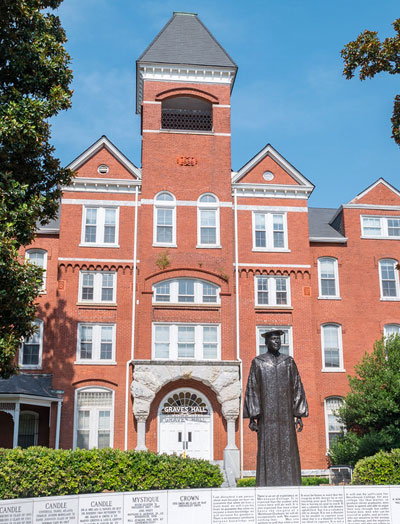DAY 12: EDUCATION PT2 – EDUCATION INACCESSIBILITY BIRTHS HISTORICALLY BLACK COLLEGES AND UNIVERSITIES
Although Dubois’s vision for equal treatment and his tenacity to move this battle forward was noble as well as needed, Washington’s conclusion was more inline with the reality of the era. White people, in general, were not ready to yield holistic freedom. So when it came to higher learning, Black people began to take the necessary steps to educate themselves. Historically Black Colleges and Universities (HBCUs) were established to educate and serve African-Americans during the reconstruction era because most predominantly White institutions (PWI’s) prevented Blacks and other minorities from enrolling based on their skin color. This racist behavior lasted long into the 20the century until civil rights activists fought for and attained anti-discrimination laws.
However, HBCUs built a vibrant and robust culture that produced countless outstanding leaders in their respective fields. Brilliant scholars, global influencers, world-class athletes, renowned musicians, leading educators, medical professionals, talented artists, innovative scientists, political heavyweights, media-giants, and a host of other trade-specialist and professionals enter the workforce from HBCUs every year. Proud HBCU alums have impacted every facet of society.
Today there are over 100 HBCUs located all across the country. We celebrate all of the efforts by the various individuals, both Black and White to build first-class institutions to serve the educational needs of Black people.
We have chosen to celebrate a select few education pioneers for their determination to change Black perception and thus change the landscape and future of our country. Today we honor their genius. We must not let their contributions be forgotten or let others bask in the credit of their achievements. Today let’s change the narrative. #LET THE TRUTH BE TOLD.
“History of HBCUs”
HBCU Alum LLC spotlights 100+ schools, their students, alumni, faculty/staff.
Historically Black Colleges and Universities (HBCUs) were established in the United States early in the 19th century, to provide undergraduate and graduate level educational opportunities to people of African descent. Black students were unwelcome at existing public and private institutions of higher education (IHEs), even after the passing of specific legislation, resulting in a lack of higher education opportunities.
In 1799, Washington and Lee University admitted John Chavis who is noted as the first African American on record to attend college. However, the first African American to have earned a bachelor’s degree from an American university, Alexander Lucius Twilight, graduated from Middlebury College in 1823. Three decades later, Mary Jane Patterson was the first African American woman to earn a bachelor’s degree, graduating from the Abolitionist-centered Oberlin College in 1862. These individuals were singular in accessing higher education.
Richard Humphreys established the African Institute (now Cheyney University) in 1837 in Pennsylvania, making it the oldest HBCU in the United States. Its mission was to teach free African Americans skills for gainful employment. Students were taught reading, writing and basic math alongside religion and industrial arts. During the 1850s, three more HBCUs were founded: Miner Normal School (1851) in Washington, D.C.; Lincoln University (1854) in Pennsylvania; and Wilberforce (1856) in Ohio. The African Methodist Episcopal Church established Wilberforce University, the first HBCU operated by African Americans. The provision of education for people of African descent in early America was recognized by some as unnecessary and criminal, while others saw it as essential and vital.
The majority of HBCUs originated from 1865-1900, with the greatest number of HBCUs started in 1867, two years after the Emancipation Proclamation: Alabama State University, Barber-Scotia College, Fayetteville State University, Howard University, Johnson C. Smith University, Morehouse College, Morgan State University, Saint Augustine’s University and Talladega College. Over a century later, HBCUs were still being established with J.F. Drake State Technical College (1961), University of the Virgin Islands (1962), Southern University at Shreveport (1967) and Morehouse School of Medicine (1975).
Approximately 89% of all HBCUs are in the southern region of the United States, although they can be found in Delaware, Illinois, Maryland, New York, Ohio, Pennsylvania, and West Virginia. North Carolina hosts eleven HBCUs, Louisiana has seven and Alabama has twelve. While many consider HBCUs to be a homogeneous group, there are levels of diversity within this unique classification of institutions, not only by academic distinction and socioeconomic status but also in student demographics. In addition, HBCUs have diverse classifications: public, private, denominational, liberal arts, land-grant, independent university systems, single-gender serving, research-based, large and small, with enrollment numbers that can range from less than 300 to over 11,000 students.


HBCU Spellman College, Atlanta GA 
HBCU Morehouse College, Atlanta GA
“LIST OF HBCU’S BY STATE”
Check out the U.S. News & World Report Listing of the Best Historically Black Colleges and Universities for 2021. To be on the list, a school must be currently designated by the U.S. Department of Education as an HBCU. To qualify for the U.S. News rankings, an HBCU also must be an undergraduate baccalaureate-granting institution that enrolls primarily first-year, first-time students and must be part of the 2021 Best Colleges rankings. In total, only 79 of the 100+ HBCUs were deemed eligible to be included on the list. Best HBCU Listing: HERE.
HBCU students are the
next generation of community leaders because they place a
higher value on community service, community leadership and civic and political engagement.
MIT PROVOST PROF. PHILIP L. CLAY
Indeed, in his 2012 Ford Foundation White Paper, Former MIT Provost Prof. Phillip L. Clay revealed that HBCU students are the next generation of community leaders, stating that HBCU students “place a higher value on community service, community leadership and civic and political engagement” than did their peers in non-HBCU institutions.
“10 Most Dominant HBCU Leaders in Recent Years”

More students with family incomes under the poverty level graduated from HBCUs than
Predominantly White Institutions (PWIs)
“Pennsylvania HBCUs”
STATE HBCUs NEED YOUR SUPPORT
| Cheyney University of Pennsylvania | Cheyney, PA |
| Lincoln University of Pennsylvania | Lincoln University, PA |
Content provided courtesy of History.com, Britannica.com and Wikipedia.com, Biographies.com, Blackpast.com, notablebiographies.com, thehbcualum.com, and tmcf.org. All Rights Reserved.


